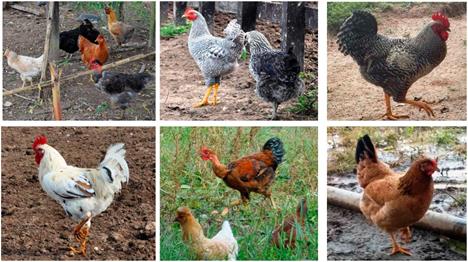Servicios Personalizados
Revista
Articulo
Indicadores
-
 Citado por SciELO
Citado por SciELO -
 Accesos
Accesos
Links relacionados
-
 Citado por Google
Citado por Google -
 Similares en
SciELO
Similares en
SciELO -
 Similares en Google
Similares en Google
Compartir
Revista MVZ Córdoba
versión impresa ISSN 0122-0268versión On-line ISSN 1909-0544
Rev.MVZ Cordoba vol.24 no.2 Córdoba mayo/ago. 2019
https://doi.org/10.21897/rmvz.1646
Research article
Morphological characterization of the creole backyard chickens of the Subregion sabana department of Sucre (Colombia)
1Universidad de Sucre, Facultad de Ciencias Agropecuarias, Sincelejo, Colombia.
Objective.
Characterize morphometric and phaneroptics of the Creole backyard hens from the savanna subregion department of Sucre (Colombia).
Materials and methods.
520 adult Creole animals (350 chickens and 170 roosters) were evaluated, in the period 2017-2018, located in 10 localities of the savanna sub-region of the department of Sucre Colombia. The information was collected in a survey format composed of quantitative and qualitative variables. The data obtained were subjected to univariate descriptive analysis, for independent samples. In addition, the analysis of variance technique was used. Comparisons between males and females were made by means of a t-test. The analyses were performed using the statistical package R.
Results.
The descriptors analyzed showed the superiority of the roosters over the hens (p<0.05). The analysis of variance in the population of females with respect to weight determined that there are significant differences (p<0.05). The morphological and phaneroptic characteristics studied describe a yellow metatarsal bird, with plumage color that combines brown, black, gray and white tones, the morphology and distribution of feathers in most birds is normal characteristic (smooth typical), with a uniform distribution to a length of the body, although specimens with different plumage patterns can be found.
Conclusions.
A wide variation could be observed among animals from the 10 localities studied. There is evidence of a typological differentiation in relation to the weight and size of the tarsus in the animals evaluated, which can be used as a selection criterion.
Keywords: Conservation; genetic resources; morphometric; phaneroptic characteristics; poultry farming (Source: CAB)
Objetivo.
Caracterizar morfométrica y faneróptica de la gallina Criolla de traspatio de la subregión Sabana, departamento de Sucre (Colombia).
Materiales y métodos.
Se evaluaron 520 animales adultos criollos (350 gallinas y 170 gallos), en el periodo 2017-2018, ubicados en 10 localidades de la subregión Sabanas del departamento de Sucre Colombia. Se recolectó la información en un formato de encuesta integrado por variables cuantitativas y cualitativas. Los datos obtenidos fueron sometidos a análisis descriptivos univariado para muestras independiente. Además, se empleó la técnica de análisis de varianza. Las comparaciones entre machos y hembras se realizaron mediante una prueba de t. Los análisis fueron realizados usando paquete estadístico R.
Resultados.
Los descriptores analizados mostraron superioridad de los gallos sobre las gallinas (p<0.05). El análisis de varianza en la población de hembras con respecto al peso, determino que existen diferencias significativas (p<0.05). Las características morfológicas y fanerópticas estudiadas, describen un ave de metatarso amarillo, con color de plumaje que combinan tonalidades marrones, negras, gris y blanco, la morfología y distribución de las plumas en la mayoría de las aves es de característica normal (lisa típica), con distribución uniforme a lo largo del cuerpo, aunque se pueden encontrar ejemplares con patrones de plumaje diferente.
Conclusiones.
Se pudo observar una amplia variación entre animales procedentes de las 10 localidades estudiadas. Se evidencia una diferenciación tipológica con relación al peso y al tamano del tarso, en los animales evaluados, lo que puede ser utilizado como criterio de selección.
Palabras clave: Avicultura; características fanerópticas; conservación; morfometría; recurso genético (Fuente: CAB)
INTRODUCTION
The hen (Gallus gallus domesticus) is a species with worldwide distribution, which was not domesticated in the near or middle east. Archaeological evidence found in the Indus Valley (Pakistan) and the Chinese province of Hebei, suggest that this species was domesticated from the red jungle rooster around the year 7400-8000 years 1,2, expanding towards Western Europe, possibly, through Russia. Domestication may have occurred separately in India or have been introduced through South Asia 3,4,5,6.
Two hypotheses of the process of formation of the domestic hen have been proposed; the first of them of monophyletic origin, while the second supports multiple origins from several subspecies of Gallus gallus that could be considered as possible progenitors 1,3. However, the most important races emerged during the second half of the 19th century (White Leghorn, New Hampshire and Plymouth Rock) 7.
There are several theories of the arrival of the hen in America, one of which states that they arrived in the Americas during the first trips of Christopher Columbus 6; other states that they arrived in South America from Easter Island, located southeast of the Pacific Ocean and introduced to the continent by people from Polynesia 8.
There are different types of poultry; within them, the poultry farming of Creole hens has zootechnical importance not for the production of eggs for the market, since their annual productions are very low 6,9, their rationality lies in constituting an important source of food for peasant families, contributes to the economic base of the family and is an important zoogenetic resource 10. The concept of Creole hen according to Tovar et al 11, is that hen native to the place where it has developed its characteristics for its survival; it is well recognized that constant cross-breeding has been developed there since before the discovery of America, either by itself or by human intervention 6,9.
Backyard poultry farming, known as rural or creole, is a traditional system of livestock production carried out by peasant families in the patio of their homes or around them, they are fed with inputs produced by the peasants themselves or what they eat. Themselves in the field and waste from the family unit 7. The problems faced by avian genetic resources at present are the reduction of genetic variability within breeds, the rapid disappearance of local breeds and lines of domestic animals through the introduction of exotic breeds, warm, humid climates and others. Hostile environments. Thus, the conservation of pure natural races, both in the wild and in the protected environment, emerges as an alternative to develop various studies, which should present as baselines the identification and characterization of exploited landraces, maximizing their genetic variability, whereas, the substitution of indigenous breeds for commercial lines constitutes a real threat to local poultry genetic resources. The objective of the present study was the morphometric and phaneroptic characterization of the backyard hen of the Sabana subregion, department of Sucre (Colombia).
MATERIALS AND METHODS
Location. 520 Creole adult animals (350 chickens and 170 roosters) were characterized, in the period 2017 2018, located in 10 localities of the sub-region Savannas of the department of Sucre (Sincelejo, Sincé, El Roble, San Pedro, Sampués, Los Palmitos, Galeras , Buenavista, Corozal and San Juan de Betulia). The climate of the study area is characteristic of tropical dry forest areas, relicts of secondary vegetation persist; there are stubble and extensive areas of grassland. The average annual temperature is 27.2°C, with fluctuating rainfall between 900 and 1275 mm per year and the relative humidity of 80% 12,13. The production units selected by a municipality, usually perform traditional management for the breeding of Creole stock (Gallus gallus domesticus - Phasianidae).
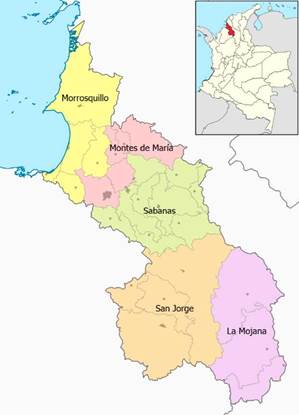
Figure 1 Location of study area, savanna sub-region, department of Sucre Colombia. Source: wikimedia.org
The information was collected in a form, which integrated quantitative and qualitative variables. For the characterization, all the hens and adult roosters found in the unit were examined, only those animals of reproductive age were selected.
Morphometric characterization. The morphometric descriptors evaluated corresponded to 14 quantitative variables suggested by FAO 14, for the characterization of the poultry resource and adapted by Lázaro et al 15 and Villacís et al 16. For morphological analysis, the following descriptors were considered: weight (kg), body length, thoracic perimeter, thigh length, leg length, tarsal length, wing length and width, height of the ridge, length and width of the appendage, length and width of the chin and tail length; the length measurements were expressed in centimeters.
The following phaneroptic characteristics were also analyzed: feather morphology, plumage distribution, plumage pattern, tarsus color, ridge size and ear lobe color. On the other hand, two important descriptors were selected that according to Villacís et al 16 and Chicoya et al 17, are directly related to the morphological differentiation of the hens and were the body weight (g) and the length of the tarsus (cm).
Data analysis. The birds were weighed and measured using a digital table scale with a capacity of 6 kg and 0.001 g of the resolution, a tape measure and a scale with 0.03 mm accuracy. The data obtained were subjected to univariate descriptive analyzes for independent samples. Additionally, the analysis of variance technique was used. The comparisons between males and females were made by means of a t-test. The analyses were performed using the statistical package R 18.
RESULTS
In tables 1 and 2, the average results of the morphometric measurements recorded in chickens and Creole roosters are shown. In all the zones, the results of the observed mean values of the descriptors analyzed showed the superiority of the roosters over the hens (p<0.05).
Table 1 Morphometric measurements in hen Creole biotypes in communities of the savanna subregion of the department of Sucre Colombia.
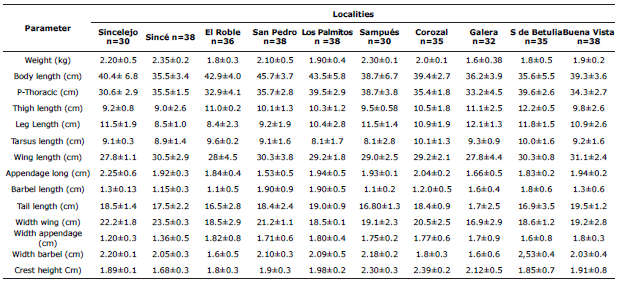
Table 2 Morphometric measurements in roosters biotypes in Creole communities of the savanna subregion of the department of Sucre Colombia.
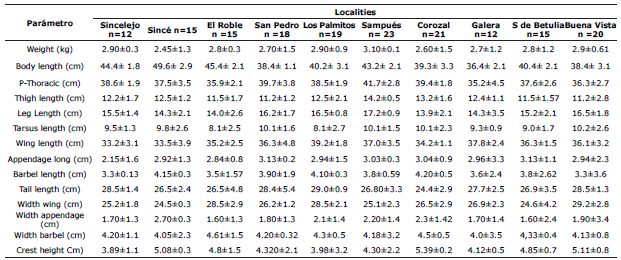
Localities
The analysis of variance in the population of females with respect to the weight determined that there are differences (p<0.05), establishing three groups of hens: heavy, light and semi-heavy (Table 3). In the same way, the grouping of males in two conglomerates (heavy males and light males) was established.
Table 3 Morphometric variables of morphological differentiation of Creole hen and roosters biotypes in communities of the savanna sub-region of the department of Sucre Colombia.
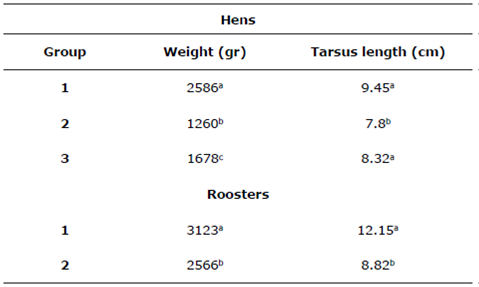
Regarding the variable size of the tarsus, 2 groups were differentiated for hens and roosters, one of the large animals and the other of medium animals (Table 3).
In table 4, the results of the analysis of the phaneroptic characteristics are observed. It was evidenced, a standard of hen and cock with a dominance of plumage with normal characteristic, with a frequency of 90% and 95% respectively. The distribution of the plumage is mainly of characteristic normal (hens 77% and roosters 75%) and the pattern of the plumage is uniform in 66%. There are basic colors that predominate in the plumage of hens and roosters such as the color brown, with a frequency of 38% and 31%, then black with 23.16%, gray with 14.76% and white with 11.70%. However, these colors are combined with other feather colors, mainly on wings, back and tail (Figure 2).
With respect to the color of the tarsus, 51% of the hens and 85% of the roosters, presented yellowish coloration, followed by white and black colorations in the females and green in the males.
In the characteristics of the head, it was determined that the hens have a peak size that oscillates between slightly small and medium (43% and 53% respectively), with three to four well-defined teeth. The roosters in both presented a size that oscillated between medium to large in proportions of 29% to 71% respectively.
The appendages of moderate size and oval, well attached to the face and pigmented (red 65% and red-white 34%). The dominant eye color is red-orange, with a frequency of 79% and 92% in females and males, respectively.
Table 4 Absolute (AF) and relative (RF) frequencies of phaneroptic characteristics of Creole biotypes hens in communities of the savanna sub-region of the department of Sucre Colombia
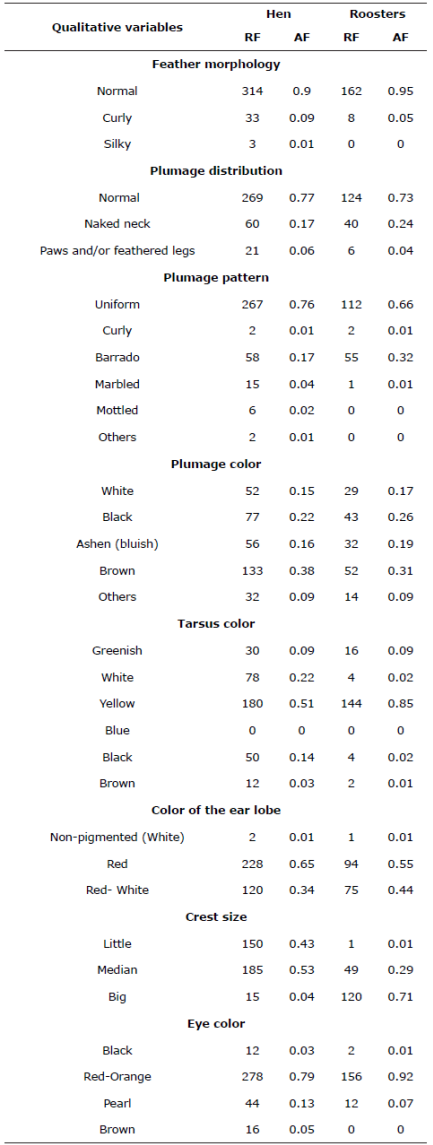
DISCUSSION
The variables weight, chest circumference, tarsus lengths and thigh lengths, together, define the size or build of the bird, which reflects the purpose of raising chickens in the production units. In this sense, the zoomometric measurements found in the animals studied (Table 1 and 2), explain the size and size of the animal, which is the basis for establishing the phenotypic descriptors as criteria for typology or grouping of the birds, which gives place to have three groups of hens and two of roosters (Table 3).
The first group of birds that were characterized as heavy, greater than 2.5 kg; therefore, they have larger limbs, such as the tarsus and leg lengths, which are reared in the production units in order to obtain eggs and meat at the end of the productive life (16).
A second group was identified as lightweight, weighing less than 1.3 kg, characterized by having smaller characteristics. This suggests that the purpose of these birds in the production unit is for laying, with which a greater number of eggs are obtained in each cycle. These results were similar to those reported by Villacís et al (16), Vega (19) and Jáuregui et al (20).
The third group of birds; which was predominant, had a weight less than 1,700 kg and medium size; evidencing that they are animals with a dual-purpose attitude, being preferred for obtaining eggs (16).
The body measurements of the males are greater (p<0.05) than those of the females (21). On average, the measurements of the females are 10% lower than the males and, in some cases, as in the size of the crest, the difference is around 200%. Similar results of zoological measurements of hen and Creole roosters were reported by Lázaro et al (15), demonstrating that in the birds studied there is no homogeneity, which facilitates the variability and concomitantly the creation of rustic and adapted tropical production lines that contribute to the conservation of traditional and socially sustainable production systems for the rural population.
A comparison of proportions was made, using the Chi-square test, contrasting the color of the feather, feather morphology, plumage pattern, plumage distribution, ridge size, tarsus color, appendage color and color of the eye. The morphological and phaneroptic characteristics studied, describe a yellow metatarsal bird, with plumage color that combine brown, black, gray and white tones (20), the morphology and distribution of feathers in most birds is normal, with uniform distribution throughout the body, although specimens with different plumage patterns can be found (Table 4).
In general, the hens have an elongated head, thin and thin, they have a ridge of size ranging from medium to small, with apricot color between shades of red-white and eyes usually red-orange. On the contrary, the roosters have large-sized crests on their heads. The size and shape of the head is directly related to the sexual dimorphism of the bird (22), in the males are developed and showy, on the contrary in females, are small.
The phenotypic appearance of observed specimens corresponds, in some cases, to commercial strains, evidencing the degree of penetration of birds of introduced breeds, to the population of Creole chickens in the area. The feather animals of normal characteristic show a high frequency, which allows assuming, greater capacity of adaptation to the climatic conditions, although this characteristic is caused by the action of recessive genes (23).
In conclusion, a wide variation could be observed among animals from the 10 localities studied in this study. Based on two main descriptors, such as the weight of the animal and the length of the tarsus, the Creole hens can be grouped under the following criteria: heavy hens (over 2.5 kg); medium-heavy hens (between 1.5 and 2.49 kg); and, light hens (less than 1.5 kg). This classification can be considered as criteria for typological differentiation and selection of Creole breeding stock. Measures for the conservation of the Creole hen should be implemented as a local resource, since the results found to reflect a tendency towards homogeneity, making possible the loss of the phenotypic diversity of the Creole flock.
REFERENCES
1. Giovambattista G, Liron J, Bravi C, Prando A. El aporte de la Genética en la elucidación de la Historia de la Domesticación y Diferenciación de las Expecies Domésticas. En: Capitulo 5 [Internet]. Ciudad Autónoma de Buenos Aires: Inter-Médica; 2010 [citado 13 de marzo de 2019]. p. 73-98. Disponible en: Disponible en: https://www.conicet.gov.ar/new_scp/detalle.php?keywords=&id=19311&capitulos=yes&detalles=yes&capit_id=965996 [ Links ]
2. Balanoff A, Bever G, Rowe T, Norell M. Evolutionary origins of the avian brain. Nature. 2013;501(7465):93-6. DOI: https://10.1038/nature12424 [ Links ]
3. Miao Y, Peng M, Wu G, Ouyang Y, Yang Z, Yu N, et al. Chicken domestication: an updated perspective based on mitochondrial genomes. Heredity. 2013; 110(3):277-82. DOI: http://10.1038/hdy.2012.83 [ Links ]
4. Larson G, Fuller D. The Evolution of Animal Domestication. Annual Review of Ecology, Evolution, and Systematics. 2014; 45(1):115-36. DOI: http://10.1146/annurev-ecolsys-110512-135813 [ Links ]
5. Xiang H, Gao J, Yu B, Zhou H, Cai D, Zhang Y, et al. Early Holocene chicken domestication in northern China. PNAS. 2014; 111(49):17564-9. DOI: http://doi.org/10.1073/pnas.1411882111 [ Links ]
6. Palacios E, Álvarez L, Munoz J. Genetic diversity of Creole hens of the Colombian southwest. Archivos de Zootecnia. 2016; 65(249):73-8. DOI: http://10.21071/az.v65i249.444 [ Links ]
7. Correa J, Salas M, Franco L, Ricalde R. Indicadores de producción de huevo de gallinas criollas en el trópico de México. Archivos de Zootecnia. 2007; 56(215):309-17. URL Available in: https://dialnet.unirioja.es/servlet/articulo?codigo=2381470 [ Links ]
8. Storey A, Rami J, Quiroz D, Burley D, Addisom D, Walter R, et al. Radiocarbon and DNA evidence for a pre-Columbian introduction of Polynesian chickens to Chile. PNAS. 2007; 104(25):10335-10339. DOI: http://doi10.1073pnas.0703993104 [ Links ]
9. Valencia N. La gallina criolla colombiana [Internet]. Universidad Nacional de Colombia, Sede Palmira. Palmira, Colombia: UNIMEDIOS; 2011. 61 p. Disponible en: http://bdigital.unal.edu.co/3412/1/9789588095561.pdf [ Links ]
10. Enrique G, Sánchez E, Castillo F, Agusto R. Características fenotíicas de las gallinas criollas de comunidades rurales del sur de Ecuador. Centro de Biotecnología [Internet]. 2014 [citado 14 de marzo de 2019]; 3(1). Disponible en: Disponible en: http://revistas.unl.edu.ec/index.php/biotecnologia/article/view/30 [ Links ]
11. Tovar J, Narváez-Solarte W, Takahashi S. Baes for the colombian Gallus gallus domesticus (Phasianidae) conservation inthe departament of Caldas. Boletin Cientifico Centro de Museos de Historia Natural Universiad de Caldas. 2014; 18(1):112-22. Disponible en: http://www.scielo.org.co/scielo.php?script=sci_abstract&pid=S0123-30682014000100007&lng=en&nrm=iso&tlng=es [ Links ]
12. De la Ossa J, Botero L. Vías pecuarias e importancia en la trashumancia ganadera. Revista Colombiana de Ciencia Animal - RECIA. Revista Colombiana de Ciencia Animal. 2013; 5(1):431-8. Disponible en: https://revistas.unisucre.edu.co/index.php/recia/article/view/456 [ Links ]
13. Montes-Vergara D, De la Ossa J, Pérez-Cordero A. Determinación mediante prueba cometa del dano genético causado por uso de ivermectina en vacas cebú (Bos taurus indicus). Rev MVZ Cordoba. 2017; 22(2):5959-65. https://doi.org/10.21897/rmvz.1034 [ Links ]
14. FAO. 1981. Descriptores de especies avícolas. Banco de datos de recursos genéticos animales. Roma, Italia. vols. 13-15. [ Links ]
15. Lázaro G, Hernandez Z, Vargas L, Martínez L, Pérez A. Uso de caracteres morfométricos en la clasificación de gallinas locales. AICA. 2012; 2:109 14. Disponible en: http://www.uco.es/conbiand/aica/templatemo_110_lin_photo/articulos/2012/Trabajo049_AICA2012.pdf [ Links ]
16. Villacís G, Escudero G, Cueva F, Luzuriaga A. Características morfométricas de las gallinas criollas de comunidades rurales del sur del Ecuador. Revista de Investigaciones Veterinarias del Perú. 2016; 27(2):218-24. DOI: http://10.15381/rivep.v27i2.11639 [ Links ]
17. Chincoya H, Haro J, Salas M, Varela A, Garay A. Tipología de gallinas criollas en valles centrales Oaxaca con base en descriptores morfométricos. Agricultura Sociedad y Desarrollo. 2018; 15(4):585-93. DOI: http://10.22231/asyd.v15i4.901 [ Links ]
18. R: The R Project for Statistical Computing [Internet]. [citado 14 de marzo de 2019]. Disponible en: Disponible en: https://www.r-project.org/ [ Links ]
19. Vega V, Roman S, Duran M, Velez A, Cabrera E, Cantu A, et al. Morphological evaluation Mexican backyard chickens (Gallus gallus domesticus). Revista Mexicana de Ciencias Pecuarias. 2018; 9(2):1-14. DOI: http://dx.doi.org/10.22319/rmcp.v9i2.4484 [ Links ]
20. Jáuregui R, Flores H, Vasquez L, Oliva M. Caracterización morfométrica de la gallina de cuello desnudo (Gallus domesticus nudicollis) en la región ch'ortí de Chiquimula, Guatemala. Ciencia, Tecnología y Salud. 2015; 2(1):1-8. Disponible en: https://digi.usac.edu.gt/ojsrevistas/index.php/cytes/article/viewFile/42/41 [ Links ]
21. Zaragoza M, Rodríguez H, Hernández Z, Perezgrovas G, Martínez C, Méndez E. Caracterización de gallinas Batsi Alak en las tierras altas del sureste de México. Archivos de Zootecnia. 2013; 62(239):321-32. DOI: http://10.21071/az.v62i239.638 [ Links ]
22. Negassa D, Melesse A, Banerjee S. Phenotypic characterization of indigenous chicken populations in Southeastern Oromia Regional State of Ethiopia. Animal Genetic Resources/ Resources génétiques animales/Recursos genéticos animales. 2014; 55:101-13. DOI: http://10.1017/S2078633614000319 [ Links ]
23. Valdés RJ, Pimentel O, Martínez K, Ferro E. Caracterización fenotípica del genofondo avícola criollo de San Andrés, Pinar del Río, Cuba. Archivos de Zootecnia. 2010; 59(228):597-600. Disponible en: http://scielo.isciii.es/scielo.php?script=sci_abstract&pid=S0004-05922010000400013&lng=es&nrm=iso&tlng=es [ Links ]
How to cite (Vancouver) Montes VD, de la Ossa VJ, Hernández HD. Morphological characterization of the creole backyard chickens of the Subregion sabana department of Sucre (Colombia). Rev MVZ Cordoba. 2019; 24(2):7218-7224. DOI: https://doi.org/10.21897/rmvz.1646
5This article is distributed under the terms of the Creative Commons Attribution 4.0 International License (https://creativecommons.org/licenses/by-sa/4.0/), which permits unrestricted use, distribution, and reproduction in any medium, provided you give appropriate credit to the original author(s) and the source. 
Received: November 01, 2018; Accepted: March 01, 2019; Published: May 01, 2019











 texto en
texto en 

